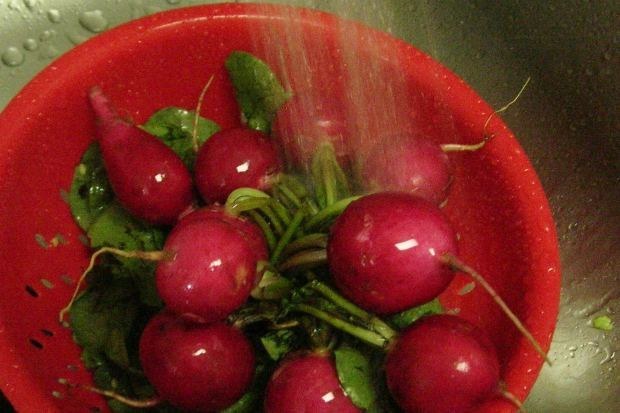Why wash fruits and vegetables
Why do you need to wash vegetables and fruit? Through washing to remove the fruit from contamination. But for many, pollution is only when the vegetable (fruit) covered with sand, dust or soil. And rinsing under running water is sufficient. Few people know that the fruit may contain pesticides, which the plant was processed in the process of growth, of harmful microorganisms, in time to settle on the surface of the product during its transportation, as well as wax and paraffin, is actively used today for processing of vegetables and fruits. When ingested, these substances can cause serious intestinal disorders and painful allergies. Therefore, thorough washing of vegetables and fruits is a prerequisite of their use.
Individual approach: how to wash vegetables and fruits
Currently, the chemical industry offers consumers a variety of tools for washing vegetables and fruits. Many manufacturers are positioning their product as natural, biodegradable, completely harmless to human health, and it is very effective remedy against all types of contamination which may take place on the vegetable or fruit. Of course, the question of confidence in the manufacturer and use of such a detergent is a personal matter, but still worth thinking about: in fact, cleaning the surface of the fruit from impurities, you saturate it with other chemical elements, which in one form or another are contained in this tool.
About how to wash vegetables and fruit are the usual means for washing and other disinfectant products may not be considered. Not less efficient, but harmless to health, the people's ways.
There is a General rule: the faster will be the process of washing vegetables and fruit (berries), the more vitamins in them will continue. But the speed should not affect quality. There washed products better immediately after washing — often when washing fruit skin is damaged, it begins to deteriorate rather quickly and, therefore, lose their useful properties.
Technology wash all fruits and vegetables are different, and depends on the characteristics of the fruit.
Roots, which can be covered with earth (potatoes, radishes, carrots, beets), you need to take a little in warm water. Then land carefully cleaned with a brush, and the vegetables are well washed: first with warm and then with cold water. After that, peel the vegetables, preferably using a stainless steel knife — so useful properties of the product are retained better. If under the skin of the detected spots of yellow, the fruits are better to eat not eat: the nitrate content in vegetables is very large. To neglect washing the vegetables that you will later be clear, it is not necessary that the peel can bring harmful bacteria.
Tomatoes, cucumbers, eggplant, squash, zucchini, peppers, pumpkins, beans should be thoroughly cleaned under running water with your hands or with a brush (sponge).
Before wash onion, cut it from the bottom, then clean and rinse with cold water from the tap. Leeks should be cleaned from the spoiled leaves, cut lengthwise, and rinse with cool water in a roomy bowl.
Iceberg vegetables (cabbage) before washing with cool water need to be cleaned from external pages are, like the stalk, are a source of nitrates. Cauliflower before rinsing with cool water is better to break it into florets and free from darkened areas.
Green onions, dill, parsley, sorrel, rhubarb, salad greens first loop, remove the roots, yellowing and damaged leaves. Then wash your greens in a container of cool water, changing the water periodically, while at the bottom does not settle all the dirt and the water in the tank is clean. After that, rinse the vegetables under the tap. Grandmothers and great-grandmothers for the best cleansing greens from pathogenic bacteria and germs, and kept it for half an hour in a salt-vinegar solution (1 tablespoon of salt and vinegar per 1 liter of water).
Corn on the cob need to free from all leaves and rinse under the tap.
Apples, pears, plums, apricots, bananas, pomegranates, peaches should be thoroughly washed with warm running water with a brush or sponge (using soap). If the fruits are imported, they definitely need to remove the peel. And before you give such fruit child, you need to soak in a container of cool water — it will take a significant portion of harmful substances.
Citrus (oranges, tangerines, lemons, pomelo, grapefruit) before washing in warm running water should be scalded with boiling water — this will help to get rid of surface preservatives.
Grapes should be washed under running water, preferably, divided into bunches.
To wash strawberries, cherries, raspberries, currants and other berries good the following method: put the berries in a colander in a single layer and rinse under running water for 5 minutes. So from the surface will descend to the ground or dust. Then the berries need to make contrast "baths": alternately dipping the colander in a bowl of very hot (but not boiling) and very cold water. 2-3 procedures is enough to remove all the germs.
And most importantly, when choosing fruit and vegetables should give preference to products of local producers, without chemical treatment. And even better — to buy the fruit grandmothers who sell them on the market. Or — if possible — to grow.
